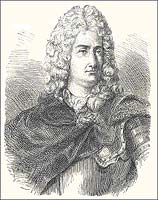A guest post by Michael Bycroft, a PhD Student at Cambridge.
Michael Bycroft writes…

René Réaumur
In a recent post Peter Anstey asked: “When did the French embrace experimental philosophy?” In this post I want to do two things. One is to draw attention to two Frenchmen who practised experimental natural philosophy (ENP) well before Jean-Antoine Nollet began teaching this method in the mid-late 1730s. These men were René Réaumur and Charles Dufay. My other task is to try to explain why these men, who did so much to practice ENP, did so little to explicitly define or defend their practice.
René Réaumur (1683-1757) was arguably the most active and influential member of the Académie des Sciences in the first half of the eighteenth century. Nowadays he is known for his research on insects, steel-making, and thermometry, but his interests were truly encyclopaedic. Charles Dufay (1698-1739) is known to historians of physics as a student of electricity, but his research interests were nearly as broad as those of Réaumur, his patron and collaborator.
There is no doubt that these two men practiced ENP. It is true that they were Cartesians, in the sense that their chief theoretical resources were vortices and subtle fluids. But they wore their theory lightly, and they saw themselves primarily as experimenters rather than as system-builders. This pair was at least as committed to ENP, and in some cases more so, than their French colleague Nollet or their English counterparts Francis Hauksbee the Elder and John Desaguliers.
Yet it is hard to find clear, succinct, accessible endorsements of the key tenets of ENP in the writings of Dufay and Réaumur. Such endorsements do exist, but they are invariably buried in the middle of one or other of the many papers they published in the Académie’s journal, the Mémoires de l’Académie Royale des Sciences. Here is an example from one of Réaumur’s first papers, on the growth of shells, published in the 1709 volume of the Mémoires:
- But conjectures such as these [ie. the ones Réaumur had just advanced in the first part his paper] are not enough in true natural philosophy. Experiments performed on the matters at hand are the only sound basis for our reasoning…It is to experiments that I shall turn to decide whether I have correctly described the manner in which nature behaves, or whether [instead] everything I have said is merely a trick of the imagination.
- Mais de pareilles conjectures ne suffisent point en bonne Physique. Les seules expériences faites sur les choses dont il est question, y doivent servir de bases à nos raisonnemens. … C’est aux experiences que je vais rapporter à faire voir, si j’ai véritablement décrit la maniere dont la Nature agit, ou si l’on doit regarder tout ce qu’on vient d’avancer comme un simple jeu d’imagination.
This statement is clearly in the spirit of ENP, and similar statements can be found elsewhere in Réaumur’s papers, and in Dufay’s. But they are fleeting asides rather than stand-alone manifestos. Why were these men so reticent?
An important part of the answer is that the stand-alone manifestos of Nollet, Hauksbee and Desaguliers appear in the prefaces of their natural philosophy textbooks, and Dufay and Réaumur did not write textbooks. They did not need to. They were independently wealthy, drew sizeable pensions from the Academy, and were well-rewarded by the state for their research on French industries such as steel and textiles.
Perhaps it is also relevant that Bernard le Bovier de Fontenelle, the Perpetual Secretary of the Academy, did much to define and defend the Academy’s activities on behalf of its members.
Another factor may be that Dufay and Réaumur were more concerned to defend the application of natural philosophy to industry (against skeptical artisans and ministers) than they were to defend the application of experiment to natural philosophy (against speculative philosophers). At any rate, the former concern dominated the preface to Réaumur’s first book, L’art de convertir le fer en acier (1722).
Finally, as we have seen, Dufay and Réaumur dispensed methodological advice in the course of the papers they published in the Academy. Perhaps they considered this the best forum for expressing their views on ENP, even though this choice makes their views harder for the historian to identify than if they had written textbooks or dictionary entries instead.
This is not to say that Dufay and Réaumur had no connections with earlier and later textbook writers on ENP in France. On the contrary. They both learned much of their physics from Jacques Rohault’s Traité de physique, and in their turn they taught Nollet much of what he knew about experimentation (Nollet assisted both Dufay and Réaumur in their laboratories in the early 1730s). These connections reinforce the broader lesson of this post, which is that the leading practitioners of ENP were not always its most explicit promoters.


